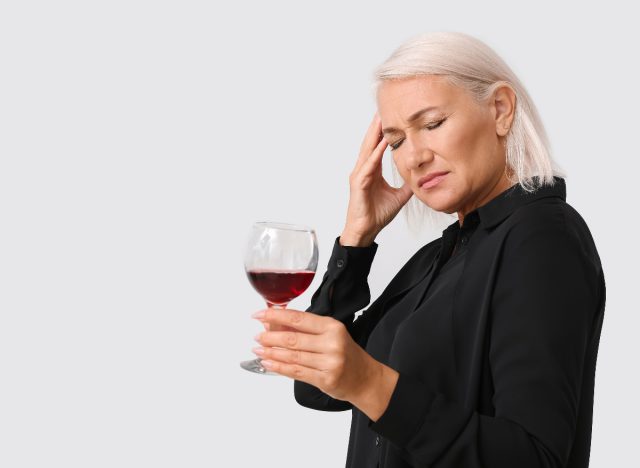‘Tis the season for dining… and wine-ing! But before you sit in front of the fire with a holiday charcuterie board and a glass of your favorite merlot or cabernet in hand, listen up. New research published in Scientific Reports, from scientists at the University of California, Davis, reveals “red wine headaches” are a thing. Let’s be honest: Having a headache after a night of sipping wine can be the worst. Read on to learn why some people get a red wine headache, and when you’re finished, be sure to check out People Swear by the ‘3-2-1’ Method for a Slim Waist: ‘Changed My Life’.
A new study reveals what causes a red wine headache.


We’ve all been guilty of indulging in a little too much wine and waking up the next morning feeling hungover, but this new study is specific to red wine and shows that a red wine headache can even come on after enjoying just a small glass. In addition, it can happen within 30 minutes to three hours after your drinking merriment.
The research team discovered why this pesky headache occurs, along with why it affects individuals who don’t typically get headaches when sipping small amounts of other types of alcohol. The scientists believe the root of the problem is “Quercetin,” a flavanol that’s a natural element in many fruits and veggies—and that includes grapes. Quercetin is actually a healthy antioxidant and can be purchased in supplements as well. In fact, according to recent research published in Pharmaceuticals, Quercetin comes with a plethora of health benefits, such as offering anti-inflammatory, antiviral, antimicrobial, and anticancer properties. The issue lies when Quercetin metabolizes with alcohol, aka red wine.
Wine chemist and corresponding author Andrew Waterhouse, professor emeritus with the UC Davis Department of Viticulture and Enology explained, “When it gets in your bloodstream, your body converts it to a different form called quercetin glucuronide. In that form, it blocks the metabolism of alcohol.”
READ RELATED: 10 Most Useful Wellness Gifts You'll Enjoy Forever
Because of this, enjoying your red wine can result in an accumulation of acetaldehyde, which is a toxin, according to the lead author of the study, Apramita Devi, a postdoctoral researcher with the UC Davis Department of Viticulture and Enology. “Acetaldehyde is a well-known toxin, irritant, and inflammatory substance. Researchers know that high levels of acetaldehyde can cause facial flushing, headache, and nausea,” Devi revealed.
The amount of Quercetin can fluctuate a great deal, depending on the red wine you drink or buy, according to Waterhouse. “Quercetin is produced by the grapes in response to sunlight. If you grow grapes with the clusters exposed, such as they do in the Napa Valley for their cabernets, you get much higher levels of quercetin. In some cases, it can be four to five times higher.”
Alexa Mellardo








